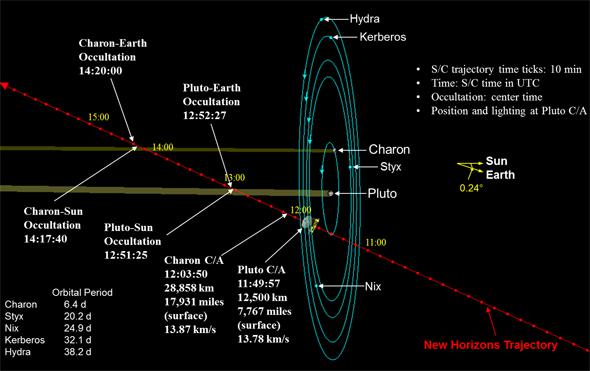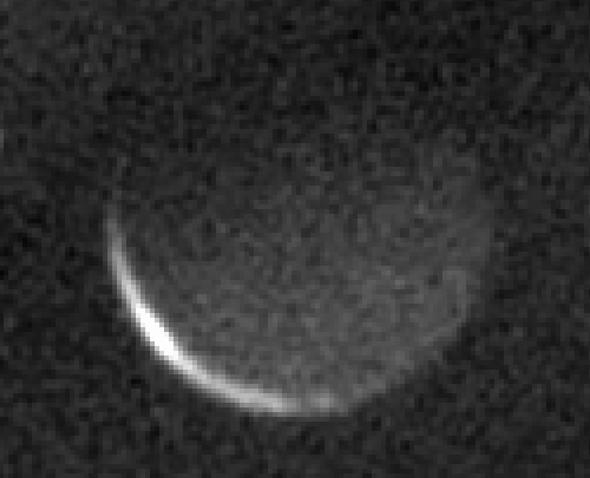In a long list of really unusual images of Pluto’s big moon Charon taken by the New Horizons spacecraft, the one above may be the most unusual. And most poetic.
It’s Charon, lit by Plutolight.
Let me explain.
Pluto is so far from the Sun—3 billion kilometers—that to it, the Earth and Sun are basically in the same direction. Even though the probe picked up a boost by swinging past Jupiter, it still is on a trajectory that’s basically pointing away from the Sun.
So it passed through the Pluto system nearly perpendicular to the orbital plane of the moons, like a dart thrown at a dartboard. Here’s a diagram showing its path:

Photo by NASA/JHUAPL/SwRI
Once it passed Pluto and Charon, New Horizons spun around to see them backlit by the Sun (that’s how the phenomenal images of Pluto’s atmosphere and haze layers were taken). That was on July 15, 2015. Two days later the spacecraft was more than 2 million kilometers past the system, five times the distance of the Earth to the Moon. From that angle, both objects looked like thin crescents from New Horizons. In the Charon picture, you can see the bright slice of the moon lit by the Sun.
However, if you were standing on Charon’s surface on the night side facing Pluto, the sky would have been dominated by Pluto itself, looking roughly half full. Even though the Sun is far away, and only feebly illuminates Pluto, the tiny world is highly reflective. The sunlight bounced off its surface and lit up the night side of Charon. That light was then reflected into space, with some of it collected by New Horizons’ camera. That’s why the night side of Charon is faintly aglow. That’s Plutolight!
The same thing happens with our Earth and Moon, when you see the dark side of the new Moon faintly glowing. That’s Earthlight, sunlight reflected off Earth, which hits the Moon, and then reflects back to us on Earth (it happens with Saturn’s moons, too). This phenomenon is sometimes called “the old Moon in the New Moon’s arms”.
Incidentally, this is a view of Charon we can never get from Earth. We always see it and Pluto fully lit, their dark sides facing away from us, hidden away.
So here we have the old Charon in the new Charon’s arms, due to the gentle and whisper-thin light from Pluto aiding the brighter but still cold light from the far distant Sun, a visage never before seen by those of us on our warm, blue world, so far in toward the light.
The New Horizons mission was all about science. But it comes with a bonus of poetry, as all science does.
